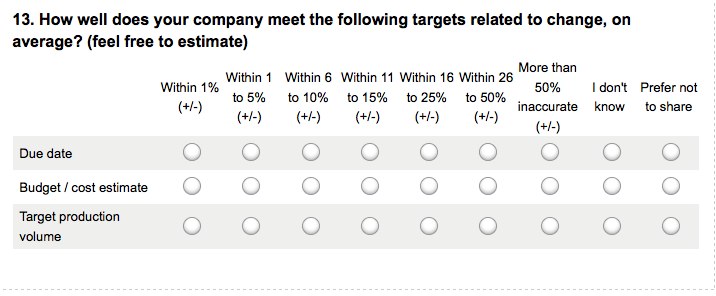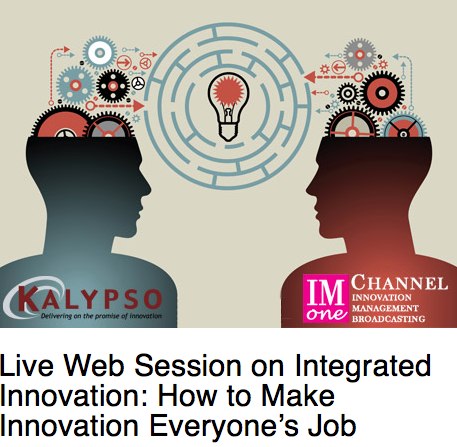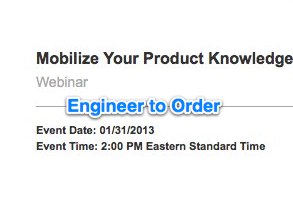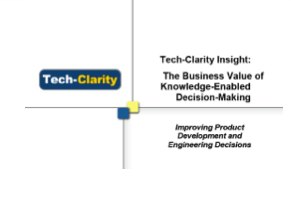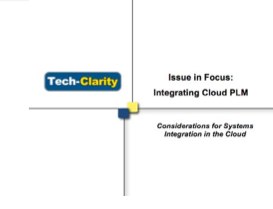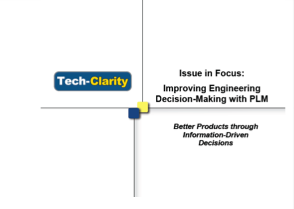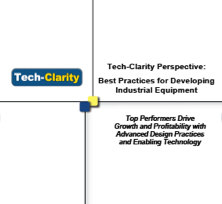Jim Brown will set the stage for this Industry Week webcast featuring Mercury Marine’s John Bayless. Jim’s presentation will feature the fundamentals of PLM including: Product and Product Development Complexity Knowledge-Based Decisions and Information Overload Operational and Business Value of PDM and PLM Thanks to Siemens PLM for sponsoring this educational webcast! Register for the…
- Product and Product Development Complexity
- Knowledge-Based Decisions and Information Overload
- Operational and Business Value of PDM and PLM
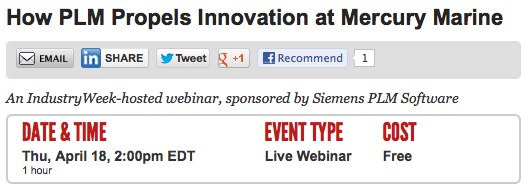 Register for the webcast or click to view the replay.
[post_title] => Industry Week Webcast PLM Driving Innovation at Mercury Marine
[post_excerpt] =>
[post_status] => publish
[comment_status] => open
[ping_status] => open
[post_password] =>
[post_name] => webcast-plm
[to_ping] =>
[pinged] =>
[post_modified] => 2022-11-14 22:26:35
[post_modified_gmt] => 2022-11-15 03:26:35
[post_content_filtered] =>
[post_parent] => 0
[guid] => http://tech-clarity.com/?p=3123
[menu_order] => 0
[post_type] => post
[post_mime_type] =>
[comment_count] => 0
[filter] => raw
)
[1] => WP_Post Object
(
[ID] => 3110
[post_author] => 2
[post_date] => 2013-03-13 13:22:51
[post_date_gmt] => 2013-03-13 17:22:51
[post_content] =>
Register for the webcast or click to view the replay.
[post_title] => Industry Week Webcast PLM Driving Innovation at Mercury Marine
[post_excerpt] =>
[post_status] => publish
[comment_status] => open
[ping_status] => open
[post_password] =>
[post_name] => webcast-plm
[to_ping] =>
[pinged] =>
[post_modified] => 2022-11-14 22:26:35
[post_modified_gmt] => 2022-11-15 03:26:35
[post_content_filtered] =>
[post_parent] => 0
[guid] => http://tech-clarity.com/?p=3123
[menu_order] => 0
[post_type] => post
[post_mime_type] =>
[comment_count] => 0
[filter] => raw
)
[1] => WP_Post Object
(
[ID] => 3110
[post_author] => 2
[post_date] => 2013-03-13 13:22:51
[post_date_gmt] => 2013-03-13 17:22:51
[post_content] =>  An exciting new article by Jim Brown explains how PPM software extends the business value manufacturers receive from ERP, PLM, and other enterprise applications. The discussion explains the importance of time to market and how PPM has emerged alongside other enterprise apps to help companies create and deliver compelling, profitable product portfolios. Read the article, Product Portfolio Management: Getting Products to Market Faster on Enterprise Apps Today.
This article was a follow up to Tech-Clarity's When Time to Market Gets Critical.
There is also a great webcast featuring Jim Brown of Tech-Clarity, Monica Alderson of Hallmark Cards and Carrie Nauyalis of Planview. View the replay of this CGT webcast, sponsored by Planview on the topic.
[post_title] => PPM Software Fills the Enterprise App Gap left by ERP and PLM in Product Development
[post_excerpt] =>
[post_status] => publish
[comment_status] => open
[ping_status] => open
[post_password] =>
[post_name] => ppm-app-gap
[to_ping] =>
[pinged] =>
[post_modified] => 2022-11-14 22:25:50
[post_modified_gmt] => 2022-11-15 03:25:50
[post_content_filtered] =>
[post_parent] => 0
[guid] => http://tech-clarity.com/?p=3110
[menu_order] => 0
[post_type] => post
[post_mime_type] =>
[comment_count] => 0
[filter] => raw
)
[2] => WP_Post Object
(
[ID] => 3080
[post_author] => 2
[post_date] => 2013-03-01 13:55:32
[post_date_gmt] => 2013-03-01 18:55:32
[post_content] =>
An exciting new article by Jim Brown explains how PPM software extends the business value manufacturers receive from ERP, PLM, and other enterprise applications. The discussion explains the importance of time to market and how PPM has emerged alongside other enterprise apps to help companies create and deliver compelling, profitable product portfolios. Read the article, Product Portfolio Management: Getting Products to Market Faster on Enterprise Apps Today.
This article was a follow up to Tech-Clarity's When Time to Market Gets Critical.
There is also a great webcast featuring Jim Brown of Tech-Clarity, Monica Alderson of Hallmark Cards and Carrie Nauyalis of Planview. View the replay of this CGT webcast, sponsored by Planview on the topic.
[post_title] => PPM Software Fills the Enterprise App Gap left by ERP and PLM in Product Development
[post_excerpt] =>
[post_status] => publish
[comment_status] => open
[ping_status] => open
[post_password] =>
[post_name] => ppm-app-gap
[to_ping] =>
[pinged] =>
[post_modified] => 2022-11-14 22:25:50
[post_modified_gmt] => 2022-11-15 03:25:50
[post_content_filtered] =>
[post_parent] => 0
[guid] => http://tech-clarity.com/?p=3110
[menu_order] => 0
[post_type] => post
[post_mime_type] =>
[comment_count] => 0
[filter] => raw
)
[2] => WP_Post Object
(
[ID] => 3080
[post_author] => 2
[post_date] => 2013-03-01 13:55:32
[post_date_gmt] => 2013-03-01 18:55:32
[post_content] =>  Tech-Clarity is conducting a research study on how top performing manufacturers manage change in their manufacturing facilities. Thank you for your interest and your participation in our survey!
Tech-Clarity is conducting a research study on how top performing manufacturers manage change in their manufacturing facilities. Thank you for your interest and your participation in our survey!
- If you already completed the survey --> please share with a colleague using the "Share/Save" options above.
- If you haven't taken the survey --> please:
click here to take the survey now!
 The presentation will discuss the business benefits and resulting complexity of customized products, and how leading manufacturers are overcoming that complexity to improve top and bottom line performance. The presentation will also share a bit about the Rulestream configuration and ETO product acquired by Siemens and how Babcock & Wilcox have taken advantage of ETO processes and technology to improve business performance.
Register for the January 31 event.
[post_title] => Webcast on Leveraging Knowledge in Engineer to Order
[post_excerpt] =>
[post_status] => publish
[comment_status] => open
[ping_status] => open
[post_password] =>
[post_name] => webcast-on
[to_ping] =>
[pinged] =>
[post_modified] => 2022-11-14 22:26:33
[post_modified_gmt] => 2022-11-15 03:26:33
[post_content_filtered] =>
[post_parent] => 0
[guid] => http://tech-clarity.com/?p=3041
[menu_order] => 0
[post_type] => post
[post_mime_type] =>
[comment_count] => 0
[filter] => raw
)
[5] => WP_Post Object
(
[ID] => 3012
[post_author] => 2
[post_date] => 2013-01-09 10:26:54
[post_date_gmt] => 2013-01-09 15:26:54
[post_content] =>
The presentation will discuss the business benefits and resulting complexity of customized products, and how leading manufacturers are overcoming that complexity to improve top and bottom line performance. The presentation will also share a bit about the Rulestream configuration and ETO product acquired by Siemens and how Babcock & Wilcox have taken advantage of ETO processes and technology to improve business performance.
Register for the January 31 event.
[post_title] => Webcast on Leveraging Knowledge in Engineer to Order
[post_excerpt] =>
[post_status] => publish
[comment_status] => open
[ping_status] => open
[post_password] =>
[post_name] => webcast-on
[to_ping] =>
[pinged] =>
[post_modified] => 2022-11-14 22:26:33
[post_modified_gmt] => 2022-11-15 03:26:33
[post_content_filtered] =>
[post_parent] => 0
[guid] => http://tech-clarity.com/?p=3041
[menu_order] => 0
[post_type] => post
[post_mime_type] =>
[comment_count] => 0
[filter] => raw
)
[5] => WP_Post Object
(
[ID] => 3012
[post_author] => 2
[post_date] => 2013-01-09 10:26:54
[post_date_gmt] => 2013-01-09 15:26:54
[post_content] => 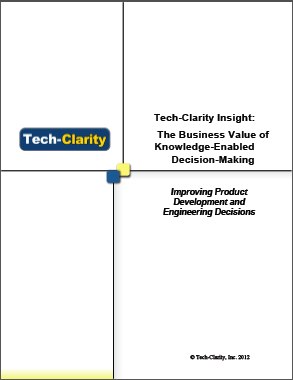 Tech-Clarity Insight: The Business Value of Knowledge-Enabled Decision-Making - Improving Product Development and Engineering Decisions shares the perspectives of three manufactures (Kimberly-Clark, Robert Bosch, and Rolls-Royce) on the value of applying knowledge-based decision-making techniques including semantic search and engineering tools. The paper also provides a template to calculate the ROI of a knowledge-based decision-making implementation and offers a representative example showing very tangible business benefits from improved search efficiency alone.
Please enjoy the summary below. Click the report or title to download a PDF overview of the report (free of charge, no registration required).
For the full report, visit the Invention Machine (IHS) website (registration required).
See the related IHS webcast Measuring the Value of Knowledge-Based Product Decisions (registration required).
Tech-Clarity Insight: The Business Value of Knowledge-Enabled Decision-Making - Improving Product Development and Engineering Decisions shares the perspectives of three manufactures (Kimberly-Clark, Robert Bosch, and Rolls-Royce) on the value of applying knowledge-based decision-making techniques including semantic search and engineering tools. The paper also provides a template to calculate the ROI of a knowledge-based decision-making implementation and offers a representative example showing very tangible business benefits from improved search efficiency alone.
Please enjoy the summary below. Click the report or title to download a PDF overview of the report (free of charge, no registration required).
For the full report, visit the Invention Machine (IHS) website (registration required).
See the related IHS webcast Measuring the Value of Knowledge-Based Product Decisions (registration required).
Table of Contents
- Executive Overview
- The Demand for Timely, Relevant Knowledge
- Too Much Information and not Enough Knowledge
- Recognize why Knowledge Management Remains a Challenge
- Improve Access to Knowledge with Semantic Search
- Understand the Basics of Semantic Search
- Extend Semantic Search with Advanced Search Tools
- Extend Semantic Search with Engineering Tools
- Understand the Value of Knowledge-Based Decision-Making
- Quantify the Value of Knowledge-Based Decision-Making
- Calculate the Benefits
- Conclusion
- Recommendations
- About the Author
Executive Overview
Optimizing the multitude of important decisions in innovation, R&D, and product development requires more than hiring the right people. Effective product decision-making demands companies make the most relevant information available to decision-makers in the right context. Innovation and problem solving require a broad array of knowledge. This information is scattered across internal and external sources such as research libraries, patent databases, and more. Further, it consists of information in many formats, document types, and languages. Aggregating and accessing the right information from the exploding volume of digital information is a significant challenge, making knowledge access an important enabler of innovation. As Tech-Clarity’s Product Data Accessibility report concludes, accessing accurate, timely information “is vital to the health and profitability of a manufacturing company.” Modern search technology offers much better value than traditional, costly knowledge management approaches that require data to be centralized, harmonized, and categorized in advance of knowing what information will actually be needed! Purpose-built semantic research tools are emerging that provide much more focused results and cut search time dramatically. “When you are searching a small amount of information, keyword searches will probably do well,” explains Sridhar Ranganathan, Technical Leader at Kimberly-Clark Corporation, “But now with so much available information, just a keyword will return too much noise.” Semantic search offers more effective knowledge retrieval without having to organize information in advance, particularly when searching large volumes of information. “Semantic search adds another dimension to the search to slice through the huge gobs of data you have more quickly,” Mr. Ranganathan explains. Developing a targeted search to drive innovation decisions is dramatically improved by translating complex problems into the fundamental, conceptual challenges that need to be addressed. Proven engineering techniques offer the opportunity to methodically break problems down into systems elements or root causes so researchers can retrieve relevant information from the vast amount of digital knowledge available today. Defining the right question to ask helps researchers find solutions from others who have solved similar problems in the past, perhaps in a different industry. Knowledge-enabled decision-making combines semantic search with engineering methods to help companies frame questions appropriately, allowing them to retrieve the most relevant information – across languages, industries and fields of study - to make better decisions. But how do you put a value on knowledge-enabled decision-making? The benefits can be invaluable, such as providing researchers with the insight to open up new markets, improve new products, or encourage greater innovation. It can also provide strategic benefits such as protecting intellectual property or discovering room to operate among existing patents. These benefits are both incredibly strategic and highly variable, but also difficult to quantify. Fortunately a highly concrete ROI is available even if companies disregard the strategic benefits and only consider tactical time savings, particularly when teams are already overworked and headcounts aren’t growing. “Even though quantifying the value is very hard, a survey among power users shows that researchers are shortening the time it takes to find solutions by using semantic search,” offers Peter Guse of Corporate Research, Innovation Management at Robert Bosch GmbH. This report provides a template to calculate these benefits based on tangible, bottom-line savings. This template is based on US census data and interviews for this paper. Applying the metrics derived from this research to a representative manufacturing company shows a cost savings of over $650,000 annually. While it’s important to remember that these are the tactical benefits and they are potentially dwarfed by the benefits of finding a new innovative product, entering a new market, or finding room to operate within a tangled web of patents, it is likely more than enough to pay for the cost of implementing knowledge-enabled decision-making technology. [post_title] => The Business Value of Knowledge-Enabled Decision-Making [post_excerpt] => [post_status] => publish [comment_status] => open [ping_status] => open [post_password] => [post_name] => knowledge-enabled-decision-making [to_ping] => [pinged] => [post_modified] => 2022-11-14 22:27:32 [post_modified_gmt] => 2022-11-15 03:27:32 [post_content_filtered] => [post_parent] => 0 [guid] => http://tech-clarity.com/?p=3012 [menu_order] => 0 [post_type] => post [post_mime_type] => [comment_count] => 0 [filter] => raw ) [6] => WP_Post Object ( [ID] => 3061 [post_author] => 2 [post_date] => 2013-01-01 10:16:32 [post_date_gmt] => 2013-01-01 15:16:32 [post_content] => Jim Brown will participate in a live discussion on IM Channel 1 with PPM guru Pamela Soin of Kalypso and Doug Shandonay, Innovation IT Lead Business Partner at Kimberly-Clark, in a presentation on Integrated Innovation: How to Make Innovation Everyone’s Job on February 7. Register for the Live Event (or watch the replay) Issue in Focus: Integrating Cloud PLM: Considerations for Systems Integration in the Cloud offers advice and insight on the integration questions companies face as they explore the applicability of Cloud PLM for their business. The report discusses existing issues such as what to integrate and how to define roles for different systems. It also analyzes new considerations that are unique to integration cloud solutions, taking lessons from more mature cloud enterprise ecosystems such as CRM.
Please enjoy the summary below, or click the report or title to download the full PDF (free of charge, no registration required).
Issue in Focus: Integrating Cloud PLM: Considerations for Systems Integration in the Cloud offers advice and insight on the integration questions companies face as they explore the applicability of Cloud PLM for their business. The report discusses existing issues such as what to integrate and how to define roles for different systems. It also analyzes new considerations that are unique to integration cloud solutions, taking lessons from more mature cloud enterprise ecosystems such as CRM.
Please enjoy the summary below, or click the report or title to download the full PDF (free of charge, no registration required).
Table of Contents
- Introducing the Issue
- Start with the Business in Mind
- Choose a Problem to Solve
- Identify the Roles PLM and other Systems Play
- Determine how PLM and other Systems will Interact
- Understand the Evolution of Cloud Integration
- Get Started
- Address IT Considerations
- Conclusion
- Recommendations
- About the Author
Introducing the Issue
Manufacturers today face increased expectations for rapid innovation while battling unprecedented product development complexity. This has driven a lot of interest in Product Lifecycle Management (PLM), including cloud-based PLM. Like more established cloud Customer Relationship Management (CRM) and supply chain offerings, cloud PLM is generating a lot of discussion. Why? The promise that the business benefits of PLM – increased revenue, decreased product cost, and reduced product development cost – can be achieved with lower investment. Tech-Clarity’s Assessing the Cloud PLM Opportunity explains that the cloud offers the potential to significantly improve PLM value by:- Leveraging economies of scale
- Eliminating non-value added work
- Taking advantage of cloud level systems performance
- Enhancing flexibility and agility while reducing business risk
- What should I integrate with PLM?
- Which solutions are responsible for which data?
- What level of integration do I need? Data only? Process? Bi-directional?
- Can I integrate cloud applications to the ones behind my firewall?
- What new integration considerations do cloud applications bring?
- Can I take advantage of cloud business benefits in integration?
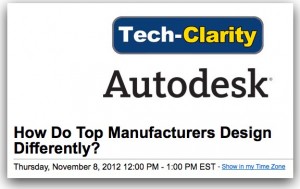 Please join Tech-Clarity and Autodesk on this webinar to share what leading companies do differently in design.
Leading manufacturers start differentiating in engineering, according to results from a recent survey of industrial equipment manufacturers. “What really sets the top performers apart is how they go about designing products," the results show according to Jim Brown. The presentation will share the best practices, engineering techniques and advanced design disciplines that leaders employ to gain an advantage.
Register and learn more about their best practices!
[post_title] => Webcast on how Leading Manufacturers Design Products
[post_excerpt] =>
[post_status] => publish
[comment_status] => open
[ping_status] => open
[post_password] =>
[post_name] => webcast-on-how-leading-manufacturers-design-products
[to_ping] =>
[pinged] =>
[post_modified] => 2022-11-14 22:26:33
[post_modified_gmt] => 2022-11-15 03:26:33
[post_content_filtered] =>
[post_parent] => 0
[guid] => http://tech-clarity.com/?p=2816
[menu_order] => 0
[post_type] => post
[post_mime_type] =>
[comment_count] => 0
[filter] => raw
)
[10] => WP_Post Object
(
[ID] => 2745
[post_author] => 2
[post_date] => 2012-09-25 11:56:56
[post_date_gmt] => 2012-09-25 15:56:56
[post_content] =>
Please join Tech-Clarity and Autodesk on this webinar to share what leading companies do differently in design.
Leading manufacturers start differentiating in engineering, according to results from a recent survey of industrial equipment manufacturers. “What really sets the top performers apart is how they go about designing products," the results show according to Jim Brown. The presentation will share the best practices, engineering techniques and advanced design disciplines that leaders employ to gain an advantage.
Register and learn more about their best practices!
[post_title] => Webcast on how Leading Manufacturers Design Products
[post_excerpt] =>
[post_status] => publish
[comment_status] => open
[ping_status] => open
[post_password] =>
[post_name] => webcast-on-how-leading-manufacturers-design-products
[to_ping] =>
[pinged] =>
[post_modified] => 2022-11-14 22:26:33
[post_modified_gmt] => 2022-11-15 03:26:33
[post_content_filtered] =>
[post_parent] => 0
[guid] => http://tech-clarity.com/?p=2816
[menu_order] => 0
[post_type] => post
[post_mime_type] =>
[comment_count] => 0
[filter] => raw
)
[10] => WP_Post Object
(
[ID] => 2745
[post_author] => 2
[post_date] => 2012-09-25 11:56:56
[post_date_gmt] => 2012-09-25 15:56:56
[post_content] => 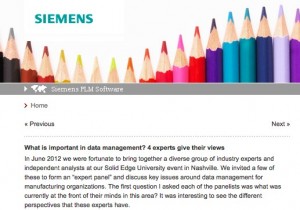 I was happy to be asked to sit on a panel focused on data management at Solid Edge University this year. I presented a keynote earlier in the day based on my recent survey on managing engineering data. Each of the panel members brought a different perspective. Panel members included:
I was happy to be asked to sit on a panel focused on data management at Solid Edge University this year. I presented a keynote earlier in the day based on my recent survey on managing engineering data. Each of the panel members brought a different perspective. Panel members included:
- Simon Floyd, Microsoft
- Ken Amman, CIMdata
- Bill McClure, Siemens PLM
- Jim Brown, Tech-Clarity (yours truly)
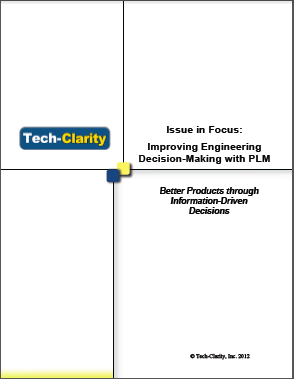 Issue in Focus: Improving Engineering Decision-Making with PLM - Better Products through Information-Driven Decisions discusses the importance of enabling engineers and product developers to make informed decisions when developing products. The report discusses how PLM must provide efficient and rapid access to product information - in context - so engineers can make optimal, information-driven decisions and develop better, more profitable products.
Please enjoy the summary below, or click the report or title to download the full PDF (free of charge, no registration required).
Issue in Focus: Improving Engineering Decision-Making with PLM - Better Products through Information-Driven Decisions discusses the importance of enabling engineers and product developers to make informed decisions when developing products. The report discusses how PLM must provide efficient and rapid access to product information - in context - so engineers can make optimal, information-driven decisions and develop better, more profitable products.
Please enjoy the summary below, or click the report or title to download the full PDF (free of charge, no registration required).
Table of Contents
- Introducing the Issue
- Increasing Challenge of Engineering Decisions
- Addressing The Product Information Challenge / Opportunity
- Enabling Engineers to Make Timely, Optimal Decisions
- Taking it to the Next Level - Supporting NPD
- Conclusion
- Recommendations
- About the Author
Introducing the Issue
Making poor product or portfolio decisions can lead to devastating impacts on fiscal performance, Likewise, making a poor engineering decision during product development can lead to catastrophic consequences. But truth be told, most decisions an engineer makes on a daily basis don’t have life or death implications. In fact, no one decision will probably be the difference between product success and failure. The combined impact of all of the decisions required to develop even a simple product, however, has a significant impact on the performance, quality, reliability, cost, compliance – and ultimately profitability – of a product. Engineering is essentially applying knowledge and science to create solutions to problems. In product development this means making decisions to address a set of requirements or needs. Engineers make thousands of decisions in product development, from big ones down to the small, everyday ones. For example, an engineering leader from GM explained at a recent conference that developing an automobile is a process consisting of over 25,000 decisions. Each of these decisions is important on its own, but more importantly the decisions are inter-related and decisions made early in product development can have a dramatic impact downstream. Given the important role of engineering decision-making in product development, manufacturers should treat it as a core competency. Manufacturers must enable decision-makers to make better, more confident decisions. They should also enable engineers to make decisions efficiently and get them right the first time to optimize product development time, reduce time-consuming design rework, and improve time to market. Optimizing engineering decisions is ultimately about driving greater success and profitability of products. Improving decision-making is even more important today as engineers face unprecedented complexity in product development. At the same time, competition is much more global and competitive advantages are easier to copy. What was a “good enough” decision ten or fifteen years ago will not suffice today. The bar has been raised. Companies are targeting “right the first time” decision-making to make more optimal, confident decisions based on better information. The engineering decision-making processes and tools of over a decade ago will not suffice either – they must evolve to enable data-driven decisions to optimize product designs. [post_title] => Improving Engineering Decision-Making with PLM [post_excerpt] => [post_status] => publish [comment_status] => open [ping_status] => open [post_password] => [post_name] => product-decisions [to_ping] => [pinged] => [post_modified] => 2022-11-14 22:27:29 [post_modified_gmt] => 2022-11-15 03:27:29 [post_content_filtered] => [post_parent] => 0 [guid] => http://tech-clarity.com/?p=2691 [menu_order] => 0 [post_type] => post [post_mime_type] => [comment_count] => 1 [filter] => raw ) [12] => WP_Post Object ( [ID] => 2710 [post_author] => 2 [post_date] => 2012-09-20 18:04:43 [post_date_gmt] => 2012-09-20 22:04:43 [post_content] => I have been truly touched to see how much support we have received from the industry on our new web show. There have been numerous tweets and posts about what Chad and I are trying to accomplish - start some serious debates about PLM and engineering software issues without taking ourselves to seriously.
I have been truly touched to see how much support we have received from the industry on our new web show. There have been numerous tweets and posts about what Chad and I are trying to accomplish - start some serious debates about PLM and engineering software issues without taking ourselves to seriously.
From Oleg posting about PLM Edutainment to this post and podcast interview by Kenneth Wong of Desktop Engineering. My thanks go out to those that believe in what we are doing.
By the way, I wonder if that picture of us on the set is me showing Chad the size of the wad of wasabi he will be brushing his teeth with?
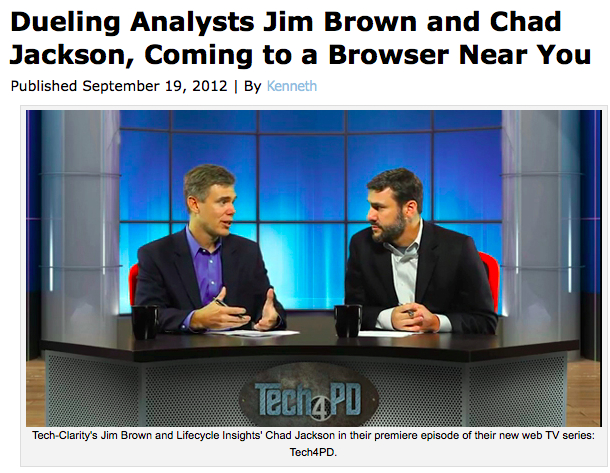 [post_title] => Desktop Engineering Covers "Dualing Analysts" in Tech4PD
[post_excerpt] =>
[post_status] => publish
[comment_status] => open
[ping_status] => open
[post_password] =>
[post_name] => desktop-engineering-covers-dualing-analysts-in-tech4pd
[to_ping] =>
[pinged] =>
[post_modified] => 2022-11-14 22:25:49
[post_modified_gmt] => 2022-11-15 03:25:49
[post_content_filtered] =>
[post_parent] => 0
[guid] => http://tech-clarity.com/?p=2710
[menu_order] => 0
[post_type] => post
[post_mime_type] =>
[comment_count] => 2
[filter] => raw
)
[13] => WP_Post Object
(
[ID] => 2591
[post_author] => 2
[post_date] => 2012-09-12 15:06:59
[post_date_gmt] => 2012-09-12 19:06:59
[post_content] => Please join Jim Brown of Tech-Clarity and Matt Klassen of PTC as they present on this Automotive News webinar, Managing the Sky-Rocketing Complexity of Automotive Systems Engineering. As complexity skyrockets, car and subsystem manufacturers must rethink their software systems engineering approach.
Attend to learn:
[post_title] => Desktop Engineering Covers "Dualing Analysts" in Tech4PD
[post_excerpt] =>
[post_status] => publish
[comment_status] => open
[ping_status] => open
[post_password] =>
[post_name] => desktop-engineering-covers-dualing-analysts-in-tech4pd
[to_ping] =>
[pinged] =>
[post_modified] => 2022-11-14 22:25:49
[post_modified_gmt] => 2022-11-15 03:25:49
[post_content_filtered] =>
[post_parent] => 0
[guid] => http://tech-clarity.com/?p=2710
[menu_order] => 0
[post_type] => post
[post_mime_type] =>
[comment_count] => 2
[filter] => raw
)
[13] => WP_Post Object
(
[ID] => 2591
[post_author] => 2
[post_date] => 2012-09-12 15:06:59
[post_date_gmt] => 2012-09-12 19:06:59
[post_content] => Please join Jim Brown of Tech-Clarity and Matt Klassen of PTC as they present on this Automotive News webinar, Managing the Sky-Rocketing Complexity of Automotive Systems Engineering. As complexity skyrockets, car and subsystem manufacturers must rethink their software systems engineering approach.
Attend to learn:
- Challenges organizations face in the design of complex systems across multiple development stages including requirements, models, verification, validation and test.
- Examples of companies which have adopted a holistic, multidisciplinary and collaborative approach to development in order to effectively design and maintain software-intensive automotive systems.
 View the archived event, presented by Microsoft.
[post_title] => Complexity of Automotive Systems Engineering Complexity Webinar
[post_excerpt] =>
[post_status] => publish
[comment_status] => open
[ping_status] => open
[post_password] =>
[post_name] => auto-systems
[to_ping] =>
[pinged] =>
[post_modified] => 2022-11-14 22:26:39
[post_modified_gmt] => 2022-11-15 03:26:39
[post_content_filtered] =>
[post_parent] => 0
[guid] => http://tech-clarity.com/?p=2591
[menu_order] => 0
[post_type] => post
[post_mime_type] =>
[comment_count] => 0
[filter] => raw
)
[14] => WP_Post Object
(
[ID] => 2524
[post_author] => 2
[post_date] => 2012-09-04 14:44:16
[post_date_gmt] => 2012-09-04 18:44:16
[post_content] => See Jim Brown's contributed article in Advantage for the Product Lifecycle, SAP Extends Technical Publishing to the Enterprise. The article explains the opportunity for manufacturers to improve their technical communications processes with solutions like Right Hemisphere, including Dassault System's 3DVIA (Composer), Anark, PTC's Arbortext, Cortona3D, Immersive Design, Lattice Technology, Quadrispace, and others. Beyond that, the article points out SAP's unique opportunity to integrate advanced publication capabilities from Right Hemisphere further into the enterprise.
Note: SAP acquired Right Hemisphere in 2011
Note 2: It has been a while since I have had an update with some of these companies, please feel free to provide insight into them and others so I can schedule some briefings to catch up.
View the archived event, presented by Microsoft.
[post_title] => Complexity of Automotive Systems Engineering Complexity Webinar
[post_excerpt] =>
[post_status] => publish
[comment_status] => open
[ping_status] => open
[post_password] =>
[post_name] => auto-systems
[to_ping] =>
[pinged] =>
[post_modified] => 2022-11-14 22:26:39
[post_modified_gmt] => 2022-11-15 03:26:39
[post_content_filtered] =>
[post_parent] => 0
[guid] => http://tech-clarity.com/?p=2591
[menu_order] => 0
[post_type] => post
[post_mime_type] =>
[comment_count] => 0
[filter] => raw
)
[14] => WP_Post Object
(
[ID] => 2524
[post_author] => 2
[post_date] => 2012-09-04 14:44:16
[post_date_gmt] => 2012-09-04 18:44:16
[post_content] => See Jim Brown's contributed article in Advantage for the Product Lifecycle, SAP Extends Technical Publishing to the Enterprise. The article explains the opportunity for manufacturers to improve their technical communications processes with solutions like Right Hemisphere, including Dassault System's 3DVIA (Composer), Anark, PTC's Arbortext, Cortona3D, Immersive Design, Lattice Technology, Quadrispace, and others. Beyond that, the article points out SAP's unique opportunity to integrate advanced publication capabilities from Right Hemisphere further into the enterprise.
Note: SAP acquired Right Hemisphere in 2011
Note 2: It has been a while since I have had an update with some of these companies, please feel free to provide insight into them and others so I can schedule some briefings to catch up. 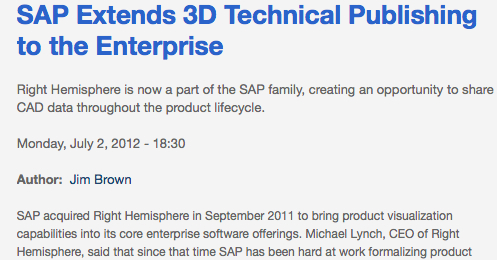 For more of Tech-Clarity's views on technical publications, please see Tech-Clarity Insight: The Business of 3D Technical Communications: Evolving Strategies to Document Products and Tech-Clarity Insight: Better Service with Better Product Information.
NOTE: Link to original article removed because it is no long available at the destination site.
[post_title] => SAP Extends 3D Tech Pubs with Right Hemisphere
[post_excerpt] =>
[post_status] => publish
[comment_status] => open
[ping_status] => open
[post_password] =>
[post_name] => sap-3d-tech-pubs
[to_ping] =>
[pinged] =>
[post_modified] => 2022-11-14 22:25:49
[post_modified_gmt] => 2022-11-15 03:25:49
[post_content_filtered] =>
[post_parent] => 0
[guid] => http://tech-clarity.com/?p=2524
[menu_order] => 0
[post_type] => post
[post_mime_type] =>
[comment_count] => 0
[filter] => raw
)
[15] => WP_Post Object
(
[ID] => 2513
[post_author] => 2
[post_date] => 2012-09-04 10:04:27
[post_date_gmt] => 2012-09-04 14:04:27
[post_content] =>
For more of Tech-Clarity's views on technical publications, please see Tech-Clarity Insight: The Business of 3D Technical Communications: Evolving Strategies to Document Products and Tech-Clarity Insight: Better Service with Better Product Information.
NOTE: Link to original article removed because it is no long available at the destination site.
[post_title] => SAP Extends 3D Tech Pubs with Right Hemisphere
[post_excerpt] =>
[post_status] => publish
[comment_status] => open
[ping_status] => open
[post_password] =>
[post_name] => sap-3d-tech-pubs
[to_ping] =>
[pinged] =>
[post_modified] => 2022-11-14 22:25:49
[post_modified_gmt] => 2022-11-15 03:25:49
[post_content_filtered] =>
[post_parent] => 0
[guid] => http://tech-clarity.com/?p=2524
[menu_order] => 0
[post_type] => post
[post_mime_type] =>
[comment_count] => 0
[filter] => raw
)
[15] => WP_Post Object
(
[ID] => 2513
[post_author] => 2
[post_date] => 2012-09-04 10:04:27
[post_date_gmt] => 2012-09-04 14:04:27
[post_content] => 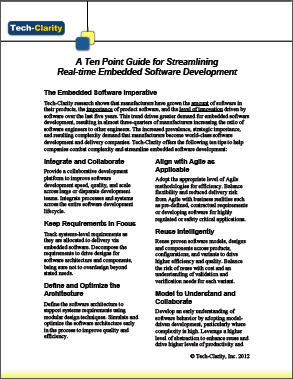 Tech-Clarity Spotlight: A Ten Point Guide for Streamlining Real-time Embedded Software Development offers ten practical suggestions that companies can use to combat complexity and streamline embedded software development.
Please enjoy the summary below, or click the report title above to download the full PDF for more details (free of charge, no registration required). Special thanks to IBM for sponsoring the distribution of this research.
Tech-Clarity Spotlight: A Ten Point Guide for Streamlining Real-time Embedded Software Development offers ten practical suggestions that companies can use to combat complexity and streamline embedded software development.
Please enjoy the summary below, or click the report title above to download the full PDF for more details (free of charge, no registration required). Special thanks to IBM for sponsoring the distribution of this research.
The Embedded Software Imperative
Tech-Clarity research shows that manufacturers have grown the amount of software in their products, the importance of product software, and the level of innovation driven by software over the last five years. This trend drives greater demand for embedded software development, resulting in almost three-quarters of manufacturers increasing the ratio of software engineers to other engineers. The increased prevalence, strategic importance, and resulting complexity demand that manufacturers become world-class software development and delivery companies. Tech-Clarity offers the following ten tips to help companies overcome these challenges by streamlining product development using systems engineering best practices:- Integrate and Collaborate
- Keep Requirements in Focus
- Define and Optimize the Architecture
- Align with Agile as Applicable
- Reuse Intelligently
- Model to Understand and Collaborate
- Proactively Manage Change
- Formalize Repeatable Processes
- Enable Visibility and Traceability
- Validate and Verify Early
 [post_title] => IndustryWeek: Product Design Strategies Take Manufacturers to the Top
[post_excerpt] =>
[post_status] => publish
[comment_status] => open
[ping_status] => open
[post_password] =>
[post_name] => iw-ie
[to_ping] =>
[pinged] =>
[post_modified] => 2022-11-14 22:25:49
[post_modified_gmt] => 2022-11-15 03:25:49
[post_content_filtered] =>
[post_parent] => 0
[guid] => http://tech-clarity.com/?p=2451
[menu_order] => 0
[post_type] => post
[post_mime_type] =>
[comment_count] => 0
[filter] => raw
)
[17] => WP_Post Object
(
[ID] => 2439
[post_author] => 2
[post_date] => 2012-08-29 15:46:45
[post_date_gmt] => 2012-08-29 19:46:45
[post_content] =>
[post_title] => IndustryWeek: Product Design Strategies Take Manufacturers to the Top
[post_excerpt] =>
[post_status] => publish
[comment_status] => open
[ping_status] => open
[post_password] =>
[post_name] => iw-ie
[to_ping] =>
[pinged] =>
[post_modified] => 2022-11-14 22:25:49
[post_modified_gmt] => 2022-11-15 03:25:49
[post_content_filtered] =>
[post_parent] => 0
[guid] => http://tech-clarity.com/?p=2451
[menu_order] => 0
[post_type] => post
[post_mime_type] =>
[comment_count] => 0
[filter] => raw
)
[17] => WP_Post Object
(
[ID] => 2439
[post_author] => 2
[post_date] => 2012-08-29 15:46:45
[post_date_gmt] => 2012-08-29 19:46:45
[post_content] => 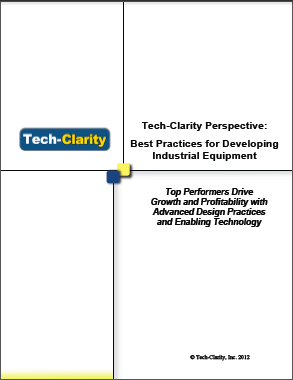 Tech-Clarity Perspective: Best Practices for Developing Industrial Equipment - Top Performers Drive Growth and Profitability with Advanced Design Practices and Enabling Technology explores best practices used by top performing industrial equipment manufacturers. The report shares insights from a survey of over 350 industrial equipment companies, and indicates what those that have most successfully grown their revenue and margins over the last two years do differently in product design and development.
Please enjoy the Executive Summary below, or click the report title above to download the a summary of the report in PDF (free of charge, no registration required).
To download the full report (free of charge, registration required), please visit the Autodesk Manufacturing Genius page.
Note: Please see related article Product Design Strategies Take Manufacturers to the Top by Travis Hessman in IndustryWeek quoting Jim Brown of Tech-Clarity and Ed Martin of Autodesk.
Tech-Clarity Perspective: Best Practices for Developing Industrial Equipment - Top Performers Drive Growth and Profitability with Advanced Design Practices and Enabling Technology explores best practices used by top performing industrial equipment manufacturers. The report shares insights from a survey of over 350 industrial equipment companies, and indicates what those that have most successfully grown their revenue and margins over the last two years do differently in product design and development.
Please enjoy the Executive Summary below, or click the report title above to download the a summary of the report in PDF (free of charge, no registration required).
To download the full report (free of charge, registration required), please visit the Autodesk Manufacturing Genius page.
Note: Please see related article Product Design Strategies Take Manufacturers to the Top by Travis Hessman in IndustryWeek quoting Jim Brown of Tech-Clarity and Ed Martin of Autodesk.
Table of Contents
- Executive Overview
- Strategies to Differentiate, Customize, Globalize
- Challenges and Performance Priorities
- Identifying the Top Performers
- Strategies of the Top Performers
- Best Practices used by the Top Performers
- Enabling Top Design and Development Performance
- Conclusion
- Recommendations
- About the Author
- About the Research
Executive Overview
Industrial equipment companies struggle to differentiate themselves in today’s highly competitive, global markets. This report investigates the business strategies, approaches, challenges, processes, and technologies these companies employ and how they impact financial performance. The goal of the research is to identify and share best practices that drive better product profitability. The results are based on 378 online survey responses from manufacturers around the globe that compete in the industrial equipment market. Analysis of the responses shows that the global economic recovery has helped industrial equipment companies economically. In fact, the companies responding to this survey have, on average, effectively grown revenue and profit margins over the last two years. Some industrial equipment manufacturers, however, have taken significantly more advantage of the recovery. These companies, the “Top Performers,” have:- Grown revenue 2.2 times more than average
- Increased profit margins 2.4 times more than average
- Modular design approaches
- Platform design techniques
- Rules-based design approaches
- Simulation tools
- Product configurators or design automation
- Product Lifecycle Management (PLM)
- Factory layout / simulation tools
 Tech-Clarity Spotlight: A Ten Point Guide for Streamlining Product Development with Systems Engineering offers ten practical suggestions that manufacturers can use to improve product development for the increasing number of products that rely on embedded software.
Please enjoy the summary below, or click the report title above to download the full PDF for more details (free of charge, no registration required). Special thanks to IBM for sponsoring the distribution of this research.
You might also be interested in viewing the Dr. Dobb’s Webcast – Ten Point Guide to Streamlining Product Development with Systems Engineering with Tech-Clarity and IBM.
Tech-Clarity Spotlight: A Ten Point Guide for Streamlining Product Development with Systems Engineering offers ten practical suggestions that manufacturers can use to improve product development for the increasing number of products that rely on embedded software.
Please enjoy the summary below, or click the report title above to download the full PDF for more details (free of charge, no registration required). Special thanks to IBM for sponsoring the distribution of this research.
You might also be interested in viewing the Dr. Dobb’s Webcast – Ten Point Guide to Streamlining Product Development with Systems Engineering with Tech-Clarity and IBM.
The Systems Engineering Imperative
Tech-Clarity research shows that manufacturers have grown the amount of software in their products, the importance of product software, and the level of innovation driven by software over the last five years. Products that combine mechanical, electrical, and software are compelling, but add tremendous product development complexity leading to quality issues, poor productivity, and delayed time to market. Tech-Clarity offers the following ten tips to help companies overcome these challenges by streamlining product development using systems engineering best practices:- Start with Requirements
- Take Time for Conceptual Design
- Optimize the Architecture
- Reuse at all Levels of Design
- Simulate the System
- Manage Change
- True Transparency
- Track and Trace it All
- Validate and Verify with the V
- Manage Configurations Continuously
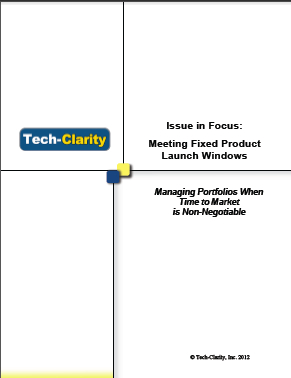 Issue in Focus: Meeting Fixed Product Launch Windows - Managing Portfolios When Time to Market is Non-Negotiable discusses the importance of stepping up product portfolio management (PPM) and new product development (NPD) performance when companies have to hit product launch windows dictated by external factors such as holidays, important industry trade shows, high fashion seasons, etc.
Please enjoy the free Executive Summary below, or click the report title above to download the full PDF (free of charge, no registration required). The full paper is also be available in the Planview Resource Center, sponsored by Planview.
Issue in Focus: Meeting Fixed Product Launch Windows - Managing Portfolios When Time to Market is Non-Negotiable discusses the importance of stepping up product portfolio management (PPM) and new product development (NPD) performance when companies have to hit product launch windows dictated by external factors such as holidays, important industry trade shows, high fashion seasons, etc.
Please enjoy the free Executive Summary below, or click the report title above to download the full PDF (free of charge, no registration required). The full paper is also be available in the Planview Resource Center, sponsored by Planview.
Table of Contents
- Introducing the Issue
- Create a Realistic Portfolio Plan
- Roadmap Product to Launch Window Relationships
- Create Detailed Project Plans
- Recognize and Account for Risk
- Execute
- Conclusion
- Recommendations
- About the Author
Introducing the Issue
Tech-Clarity research shows that reducing time to market is a high priority for companies targeting product development performance and profitability improvements. Speed is critical because the winner of the product development race can take advantage of premium pricing, higher profit margins, and a jump on the competition to lock in market share. On the other hand, the impact of delayed time to market can be significant, for example:- A pharmaceutical company may lose $1 million per day a launch is late
- Government contractors missing milestones may forgo incentives and face penalties
- Industrial products companies can miss customer commitments and expectations
- A confectionary company missing the Easter season faces significant bottom-line impact
- A high-tech company delaying release beyond an important trade show or investor conference can damage their brand and be punished by investors
- A toy company missing the Christmas season faces a huge lost opportunity
- A high fashion apparel company missing the Spring season is just not acceptable and will damage relationships with their retail partners
- Product and Product Development Complexity
- Knowledge-Based Decisions and Information Overload
- Operational and Business Value of PDM and PLM
 Register for the webcast or click to view the replay.
[post_title] => Industry Week Webcast PLM Driving Innovation at Mercury Marine
[post_excerpt] =>
[post_status] => publish
[comment_status] => open
[ping_status] => open
[post_password] =>
[post_name] => webcast-plm
[to_ping] =>
[pinged] =>
[post_modified] => 2022-11-14 22:26:35
[post_modified_gmt] => 2022-11-15 03:26:35
[post_content_filtered] =>
[post_parent] => 0
[guid] => http://tech-clarity.com/?p=3123
[menu_order] => 0
[post_type] => post
[post_mime_type] =>
[comment_count] => 0
[filter] => raw
)
[comment_count] => 0
[current_comment] => -1
[found_posts] => 802
[max_num_pages] => 41
[max_num_comment_pages] => 0
[is_single] =>
[is_preview] =>
[is_page] =>
[is_archive] =>
[is_date] =>
[is_year] =>
[is_month] =>
[is_day] =>
[is_time] =>
[is_author] =>
[is_category] =>
[is_tag] =>
[is_tax] =>
[is_search] =>
[is_feed] =>
[is_comment_feed] =>
[is_trackback] =>
[is_home] => 1
[is_privacy_policy] =>
[is_404] =>
[is_embed] =>
[is_paged] =>
[is_admin] =>
[is_attachment] =>
[is_singular] =>
[is_robots] =>
[is_favicon] =>
[is_posts_page] =>
[is_post_type_archive] =>
[query_vars_hash:WP_Query:private] => 03b5a50b78fc3f988d830823f5c3669b
[query_vars_changed:WP_Query:private] => 1
[thumbnails_cached] =>
[allow_query_attachment_by_filename:protected] =>
[stopwords:WP_Query:private] =>
[compat_fields:WP_Query:private] => Array
(
[0] => query_vars_hash
[1] => query_vars_changed
)
[compat_methods:WP_Query:private] => Array
(
[0] => init_query_flags
[1] => parse_tax_query
)
[query_cache_key:WP_Query:private] => wp_query:707fa9129c029ff2a1295164fae367b3:0.73211400 17646631670.74044700 1764663167
)
Register for the webcast or click to view the replay.
[post_title] => Industry Week Webcast PLM Driving Innovation at Mercury Marine
[post_excerpt] =>
[post_status] => publish
[comment_status] => open
[ping_status] => open
[post_password] =>
[post_name] => webcast-plm
[to_ping] =>
[pinged] =>
[post_modified] => 2022-11-14 22:26:35
[post_modified_gmt] => 2022-11-15 03:26:35
[post_content_filtered] =>
[post_parent] => 0
[guid] => http://tech-clarity.com/?p=3123
[menu_order] => 0
[post_type] => post
[post_mime_type] =>
[comment_count] => 0
[filter] => raw
)
[comment_count] => 0
[current_comment] => -1
[found_posts] => 802
[max_num_pages] => 41
[max_num_comment_pages] => 0
[is_single] =>
[is_preview] =>
[is_page] =>
[is_archive] =>
[is_date] =>
[is_year] =>
[is_month] =>
[is_day] =>
[is_time] =>
[is_author] =>
[is_category] =>
[is_tag] =>
[is_tax] =>
[is_search] =>
[is_feed] =>
[is_comment_feed] =>
[is_trackback] =>
[is_home] => 1
[is_privacy_policy] =>
[is_404] =>
[is_embed] =>
[is_paged] =>
[is_admin] =>
[is_attachment] =>
[is_singular] =>
[is_robots] =>
[is_favicon] =>
[is_posts_page] =>
[is_post_type_archive] =>
[query_vars_hash:WP_Query:private] => 03b5a50b78fc3f988d830823f5c3669b
[query_vars_changed:WP_Query:private] => 1
[thumbnails_cached] =>
[allow_query_attachment_by_filename:protected] =>
[stopwords:WP_Query:private] =>
[compat_fields:WP_Query:private] => Array
(
[0] => query_vars_hash
[1] => query_vars_changed
)
[compat_methods:WP_Query:private] => Array
(
[0] => init_query_flags
[1] => parse_tax_query
)
[query_cache_key:WP_Query:private] => wp_query:707fa9129c029ff2a1295164fae367b3:0.73211400 17646631670.74044700 1764663167
)
All Results for "All"
PPM Software Fills the Enterprise App Gap left by ERP and PLM in Product Development
An exciting new article by Jim Brown explains how PPM software extends the business value manufacturers receive from ERP, PLM, and other enterprise applications. The discussion explains the importance of time to market and how PPM has emerged alongside other enterprise apps to help companies create and deliver compelling, profitable product portfolios. Read the article,…
Managing Change in the Plant Survey
Tech-Clarity is conducting a research study on how top performing manufacturers manage change in their manufacturing facilities. Thank you for your interest and your participation in our survey! If you already completed the survey –> please share with a colleague using the “Share/Save” options above. If you haven’t taken the survey –> please: click here…
Webcast – Developing the Right New Products
Tech-Clarity will present with Kalypso on the upcoming Brighttalk summit on Balancing PPM for Business and IT. Pamela Soin and Tech-Clarity’s Jim Brown will discuss best practices for managing product portfolios in a session titled Developing the Right New Products for Customers and your Business. The conference is sponsored by CA Technologies. Register Now by…
Webcast on Leveraging Knowledge in Engineer to Order
Jim Brown will present his view on engineer to order (ETO) business value and best practices on the Mobilize Your Product Knowledge to Win More Engineer to Order Business webcast with Brian Grogan of Siemens PLM and Kip Alexander of Babcock & Wilcox. The presentation will discuss the business benefits and resulting complexity of customized…
The Business Value of Knowledge-Enabled Decision-Making
Tech-Clarity Insight: The Business Value of Knowledge-Enabled Decision-Making – Improving Product Development and Engineering Decisions shares the perspectives of three manufactures (Kimberly-Clark, Robert Bosch, and Rolls-Royce) on the value of applying knowledge-based decision-making techniques including semantic search and engineering tools. The paper also provides a template to calculate the ROI of a knowledge-based decision-making implementation…
Integrated Innovation Web Panel with Kimberly-Clark and Kalypso
Jim Brown will participate in a live discussion on IM Channel 1 with PPM guru Pamela Soin of Kalypso and Doug Shandonay, Innovation IT Lead Business Partner at Kimberly-Clark, in a presentation on Integrated Innovation: How to Make Innovation Everyone’s Job on February 7. Register for the Live Event (or watch the replay) As…
Webcast on Knowledge Enabled Decisions
Tech-Clarity’s Jim Brown will present with Ken Klapproth, Director of Product Management for IHS Product Design on a webcast discussing the business value and ROI of knowledge enabled decision making for R&D, product development, and engineering. Jim will share some findings from his upcoming white paper Tech-Clarity Insight: The Business Value of Knowledge-Enabled Decision-Making. …
Integrating Cloud PLM
Issue in Focus: Integrating Cloud PLM: Considerations for Systems Integration in the Cloud offers advice and insight on the integration questions companies face as they explore the applicability of Cloud PLM for their business. The report discusses existing issues such as what to integrate and how to define roles for different systems. It also analyzes…
Webcast on how Leading Manufacturers Design Products
Please join Tech-Clarity and Autodesk on this webinar to share what leading companies do differently in design. Leading manufacturers start differentiating in engineering, according to results from a recent survey of industrial equipment manufacturers. “What really sets the top performers apart is how they go about designing products,” the results show according to Jim Brown….
Siemens PLM Data Management Expert Panel Summary
I was happy to be asked to sit on a panel focused on data management at Solid Edge University this year. I presented a keynote earlier in the day based on my recent survey on managing engineering data. Each of the panel members brought a different perspective. Panel members included: Simon Floyd, Microsoft Ken Amman,…
Improving Engineering Decision-Making with PLM
Issue in Focus: Improving Engineering Decision-Making with PLM – Better Products through Information-Driven Decisions discusses the importance of enabling engineers and product developers to make informed decisions when developing products. The report discusses how PLM must provide efficient and rapid access to product information – in context – so engineers can make optimal, information-driven decisions…
Desktop Engineering Covers “Dualing Analysts” in Tech4PD
I have been truly touched to see how much support we have received from the industry on our new web show. There have been numerous tweets and posts about what Chad and I are trying to accomplish – start some serious debates about PLM and engineering software issues without taking ourselves to seriously. From Oleg…
Complexity of Automotive Systems Engineering Complexity Webinar
Please join Jim Brown of Tech-Clarity and Matt Klassen of PTC as they present on this Automotive News webinar, Managing the Sky-Rocketing Complexity of Automotive Systems Engineering. As complexity skyrockets, car and subsystem manufacturers must rethink their software systems engineering approach. Attend to learn: Challenges organizations face in the design of complex systems across multiple…
SAP Extends 3D Tech Pubs with Right Hemisphere
See Jim Brown’s contributed article in Advantage for the Product Lifecycle, SAP Extends Technical Publishing to the Enterprise. The article explains the opportunity for manufacturers to improve their technical communications processes with solutions like Right Hemisphere, including Dassault System’s 3DVIA (Composer), Anark, PTC’s Arbortext, Cortona3D, Immersive Design, Lattice Technology, Quadrispace, and others. Beyond that, the…
A Ten Point Guide for Streamlining Real-time Embedded Software Development
Tech-Clarity Spotlight: A Ten Point Guide for Streamlining Real-time Embedded Software Development offers ten practical suggestions that companies can use to combat complexity and streamline embedded software development. Please enjoy the summary below, or click the report title above to download the full PDF for more details (free of charge, no registration required). Special thanks to…
IndustryWeek: Product Design Strategies Take Manufacturers to the Top
An article by Travis Hessman of IndustryWeek related to the recent industrial equipment survey report Best Practices for Developing Industrial Equipment by Jim Brown of Tech-Clarity. Quotes Jim and his research extensively and includes some insightful remarks from Ed Martin of Autodesk as well.
Best Practices for Developing Industrial Equipment
Tech-Clarity Perspective: Best Practices for Developing Industrial Equipment – Top Performers Drive Growth and Profitability with Advanced Design Practices and Enabling Technology explores best practices used by top performing industrial equipment manufacturers. The report shares insights from a survey of over 350 industrial equipment companies, and indicates what those that have most successfully grown their…
A Ten Point Guide for Streamlining Product Development with Systems Engineering
Tech-Clarity Spotlight: A Ten Point Guide for Streamlining Product Development with Systems Engineering offers ten practical suggestions that manufacturers can use to improve product development for the increasing number of products that rely on embedded software. Please enjoy the summary below, or click the report title above to download the full PDF for more details…
Meeting Fixed Product Launch Windows
Issue in Focus: Meeting Fixed Product Launch Windows – Managing Portfolios When Time to Market is Non-Negotiable discusses the importance of stepping up product portfolio management (PPM) and new product development (NPD) performance when companies have to hit product launch windows dictated by external factors such as holidays, important industry trade shows, high fashion seasons,…
